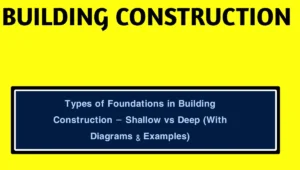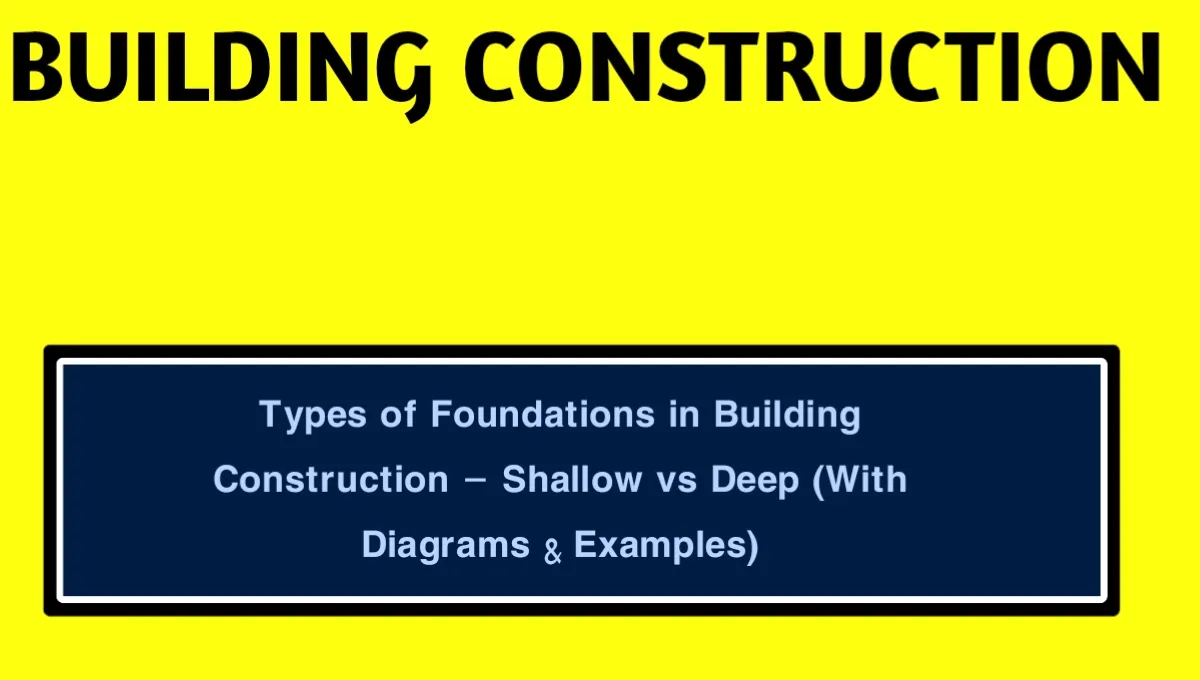Types of Foundations in Building Construction – Shallow vs Deep (With Diagrams & Examples) When constructing any building, one of the most crucial elements is the foundation. A foundation transfers the load of the building to the ground and ensures the structure’s stability and longevity. Choosing the correct type of foundation depends on various factors like soil conditions, load requirements, water table level, and budget. In this post, we’ll explore the two major categories of foundations: Shallow Foundations and Deep Foundations with diagrams and practical examples.
Types of Foundations in Building Construction – Shallow vs Deep (With Diagrams & Examples)
What is a Foundation in Construction?
A foundation is the lowest part of any building structure that connects it to the ground and safely transfers loads from the building to the earth. It ensures the building remains stable, even under adverse conditions such as earthquakes or uneven settlement.
Types of Foundations
Foundations can be broadly classified into two types:
- Shallow Foundations
- Deep Foundations
Let’s dive deeper into each.
1. Shallow Foundations
Shallow foundations are used when the load of the structure is light and the soil at a shallow depth is strong enough to support it.
Types of Shallow Foundations:
a) Spread Footing / Individual Footing
- Used for individual columns.
- Simple rectangular or square in shape.
- Cost-effective for small buildings.
b) Combined Footing
- Supports two or more columns.
- Used when columns are closely spaced.
- Economical use of space and material.
c) Strip Footing
- Long and narrow footing.
- Supports load-bearing walls.
- Common in residential buildings.
d) Raft or Mat Foundation
- Covers the entire footprint of the building.
- Used when loads are heavy or soil is weak.
- Reduces differential settlement.
Example:
For a small residential house built on strong soil, a spread footing or strip footing is commonly used.
2. Deep Foundations
Deep foundations are used when the soil near the surface is not capable of supporting the load, so the load is transferred to deeper, more stable soil or rock layers.
Types of Deep Foundations:
a) Pile Foundation
- Long, slender columns driven deep into the ground.
- Made of concrete, steel, or timber.
- Ideal for weak or compressible soil.
b) Drilled Shafts / Caissons
- Large diameter concrete shafts drilled into the ground.
- Suitable for large buildings, bridges, and towers.
c) Well Foundation
- Used in bridge piers.
- Made by sinking a circular or rectangular well.
Example:
Skyscrapers or bridges constructed on riverbeds typically use pile or caisson foundations to reach bedrock.
Shallow vs Deep Foundations: Key Differences
| Feature | Shallow Foundation | Deep Foundation |
| Depth | Less than 3 meters | More than 3 meters |
| Cost | Economical | Expensive |
| Time to Build | More | Less |
| Soil Condition | Good soil at shallow depth | Poor soil at shallow depth |
| Load-Bearing Capacity | Low to Medium | High |
| Examples | Residential homes, small buildings | Bridges, high-rise buildings |
Choosing the Right Foundation
- Choosing the right type of foundation depends on:
- Soil bearing capacity (SBC)
- Load of the structure
- Groundwater table
- Budget and construction timeline
- Type of structure (residential, commercial, industrial)
Tip: Always conduct a geotechnical investigation before deciding the foundation type.
Conclusion
Foundations are the unseen backbone of any building. Whether it’s a shallow footing for a small house or a deep pile foundation for a towering skyscraper, selecting the right type of foundation is critical. By understanding the differences between shallow and deep foundations, construction professionals can ensure safe and durable structures.
FAQs about Types of Foundations in Building Construction
1. What is the main difference between shallow and deep foundations?
A1. Shallow foundations are used when the load is transferred to soil at a shallow depth, while deep foundations transfer load to deeper strata.
2. When is a raft foundation used?
A2. Raft foundations are used when soil bearing capacity is low and the load needs to be spread over a large area.
3. What are the common materials used in pile foundations?
A3. Concrete, steel, and timber are commonly used in pile foundations.
4. Is a soil test necessary before selecting a foundation type?
A4. Yes, a geotechnical investigation or soil test is essential to determine soil properties.
5. Can shallow foundations be used for high-rise buildings?
A5. Generally, no. High-rise buildings require deep foundations due to their heavy load.
6. What is a caisson foundation?
A6. A caisson or drilled shaft is a deep foundation that is constructed by drilling a hole and filling it with reinforced concrete.
7. Which is more cost-effective: shallow or deep foundations?
A7. Shallow foundations are more cost-effective when soil conditions are favorable.
| 10 Civil Engineering Interview Questions and Answers for Freshers 2025 | Read More |
| Importance of Quality Control in Construction Projects | Read More |
| Site Engineer Responsibilities in Construction | Read More |
| Top 8 Software Tools Every Civil Engineer | Read More |
Homepage: Click Here

